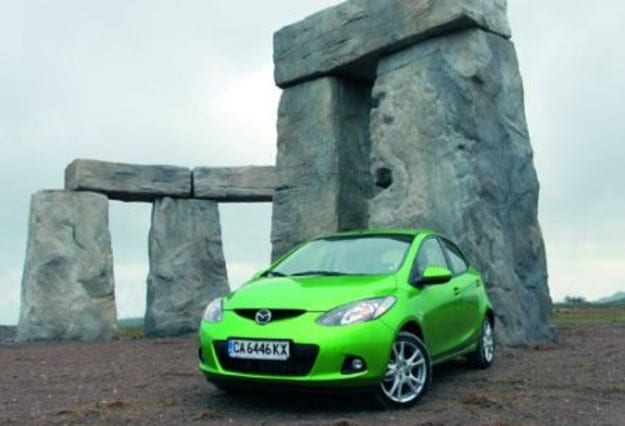
Тест драйв Mazda 2: новичок
Содержание

Новая версия Mazda 2 легче и компактнее, чем ее предшественница — это свежая и отличная идея в предложениях малого класса с каждым последующим поколением. Тестовая версия с 1,5-литровым бензиновым двигателем.
Создатели Mazda 2 нового поколения избрали интересный альтернативный путь, который обещает быть не только оригинальным, но и выгодной стратегией развития. В последнее время ускорение стало постоянным явлением в большинстве классов автомобилей и теперь считается само собой разумеющимся, но японцы подвергли его критической переоценке. Недавно вылупившаяся «пара» меньше, чем предыдущая версия — уникальный шаг в классе, в котором каждое последующее поколение становится длиннее, шире и выше своего предшественника. Пятнадцать лет назад примерно с 3,50 — 3,60 метра сегодня средняя длина автомобилей этой категории составляет уже около четырех метров. Кузов нового японца составляет ровно 3885 мм, а его ширина и высота составляют 1695 и 1475 мм соответственно. Эти меры, конечно, не превращают «парочку» в микроавтомобиль, но явно выделяют ее из ценностей, характерных для высшего класса до недавнего времени.
Больше безопасности и качества при меньшем весе
Еще любопытнее то, что японцы уменьшили не только габариты, но и вес автомобиля. Звучит потрясающе, но, несмотря на значительное улучшение пассивной безопасности, комфорта и динамики, Mazda 2 похудела примерно на 100 килограммов по сравнению со своим предшественником! Достаточно красноречиво то, что даже с самым богатым оснащением 1,5-литровая версия весит всего 1045 кг.
Понятно, что специалисты, работающие над внутренней архитектурой модели, тоже поняли работу, так как уменьшение внешних габаритов не повлияло на полезный объем в автомобиле — вопреки банальной логике, последний показывает заметное увеличение. Вы не почувствуете признаков клаустрофобии даже на заднем сиденье, если только вы не гигант ростом два метра и весом более 120 килограммов …
Свежесть и энергия
Свежее и непохожее на общепринятые взгляды послание новой «парочки» находит отклик. Дело в том, что хотя это и не является чем-то принципиально отличным по философии от остального сегмента, «пара» достаточно четко выделяется не только среди своих конкурентов, но и среди автомобильного сообщества в целом. За ним следует большое количество прохожих и водителей других транспортных средств — достаточно явный признак того, что модель производит впечатление, и, судя по явно одобрительным выражениям лиц, это впечатление преимущественно положительное … В нашем случае значительный вклад в яркий вид маленького искрящегося зеленого цвета лакового покрытия исследуемого образца. Цвет определенно добавляет разнообразия серо-черной (а в последнее время и белой) монотонности современной автомобильной моды и отлично сочетается с мускулистой динамикой кузова Mazda 2. Неслучайно большинство покупателей модели заказывают ее именно в этом цвете … Хотя Дизайн передней части автомобиля ближе к массовым тенденциям, расположение по бокам и сзади является абсолютным хитом и придает ему характерную осанку, которую невозможно спутать. Динамичный силуэт подчеркнут поднимающейся нижней линией окон и дерзко повернутой задней частью, и дизайнеров однозначно можно поздравить с поставленной перед ними задачей.
Хорошая новость заключается в том, что, как уже было сказано, динамичный внешний вид новой модели не оказал негативного влияния на свободное пространство на задних сиденьях или вместимость багажника — его объем находится в пределах обычного класса и составляет от 250 до 787 литров в зависимости от от выбранной конфигурации заднего сиденья. Единственная серьезная проблема здесь — высокий нижний край грузового отсека, который может создавать неудобства для более тяжелых или громоздких предметов, которые могут поцарапать лаковое покрытие.
Качество и практичность
Водительское кресло удобное, эргономичное и с практически неисчерпаемыми возможностями регулировки — это займет всего несколько минут, и вы будете чувствовать себя комфортно независимо от вашего пола, роста и физических характеристик. В этом плане новая «парочка» воплощает в себе одно из самых ценных качеств, характерных для японской марки — однажды сев в машину, человек буквально чувствует себя как дома. Эргономика современной приборной панели не дает повода для ни малейшего неудовлетворения, все точно на своем месте, а сиденья в автомобиле среднего класса будут смотреться неплохо. Время на привыкание к работе рулевого управления, педалей, удобно расположенного в центральной консоли рычага переключения передач и оценки габаритов автомобиля ограничивается прохождением первых 500 метров. Обзор с водительского сиденья отличный вперед и сбоку, но сочетание широких колонн и высокой задней части с небольшими окнами сильно ограничивает обзор при движении задним ходом. Однако, несмотря на этот недостаток, на фоне все более фургонных кузовов в малом классе и, соответственно, все более незначительной способности точно оценивать свои возможности маневрирования здесь все выглядит более чем хорошо. Дополнительным удобством являются изогнутые вниз боковые зеркала в области передних окон, а удобство самих зеркал позволяет создавать комплексы из более чем одного полноразмерного внедорожника.
Удивительно динамичное поведение на дороге
Поведение новой «парочки» на дороге заставит взглянуть на возможности малого класса под новым углом — предельно малый радиус поворота, удобство управления и правильный подбор цифр на пятиступенчатой трансмиссии, возможно, не такой уж большой сюрприз, но стабильность работы трасса и проходимость на участках с поворотами находятся на уровне, который до недавнего времени мог похвастаться только лучшим в компактном сегменте. Резервы шасси способствуют динамичному вождению, рулевое управление работает довольно легко, но точно, а низкая склонность к недостаточной поворачиваемости в пограничном режиме поворота проявляется довольно поздно. Боковой наклон кузова незначительный, система ESP срабатывает легко и эффективно только в случае крайней необходимости. Комфортность езды на высокой скорости и хорошее покрытие отличное, но сочетание жесткой подвески, 16-дюймовых колес и низкопрофильных шин у тестового автомобиля размером 195/45 приводит к проблемам с асфальтированным и поврежденным покрытием.
Динамичный, но немного прожорливый двигатель
Бензиновый двигатель объемом 1,5 литра обладает ярким и энергичным азиатским темпераментом — радует энтузиазм и спонтанность реакции при наборе скорости, двигатель остается в настроении до выхода на красный предел на 6000 об / мин, а тяга на удивление хороша на на фоне относительно скромного запаса крутящего момента. Японец точно не блещет вспышками неудержимой мощности ниже 3000 об / мин, но это можно легко и быстро исправить с помощью короткого рычага трансмиссии, похожего на джойстик. Высокоскоростной характер двигателя должен побудить инженеров Mazda задуматься о шестой передаче, что чрезвычайно положительно скажется на расходе топлива при движении на высоких скоростях. При 140 км / ч на шоссе стрелка тахометра показывает 4100, на 160 км / ч скорость становится 4800, а на 180 км / ч она повышается до постоянного уровня 5200, что излишне увеличивает шум и приводит к ненужному расходу топлива. Средний расход 7,9 л / 100 км определенно не повод для драмы, но некоторые участники этого класса показывают лучшие результаты в этой дисциплине. Японцы могли работать на свежесть своих клиентов даже после встречи с кассиром на заправке…
Текст: Божан Бошнаков
Фото: Мирослав Николов
Оценка
Mazda 2 1.5 GT
Mazda 2 очаровывает своим свежим дизайном, малым весом и динамичностью на дороге, а салон просторный, функциональный и хорошо оформленный. Слабые стороны модели ограничиваются такими деталями, как шумный двигатель на высоких оборотах и расход топлива, который мог бы быть более умеренным.
технические данные
| Mazda 2 1.5 GT | |
|---|---|
| Рабочий объем | — |
| Мощность | 76 кВт (103 к. с.) |
| Максимум крутящий момент | — |
| Ускорение 0-100 км / ч | 10,6 с |
| Тормозной путь на скорости 100 км / ч | 39 м |
| Максимальная скорость | 188 м / ч |
| Средний расход топлива в тесте | 7,9 л / 100 км |
| Базовая цена | 31 990 левов |
